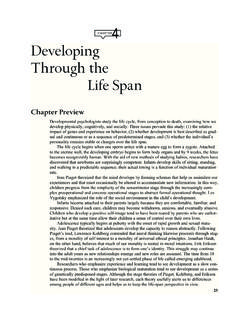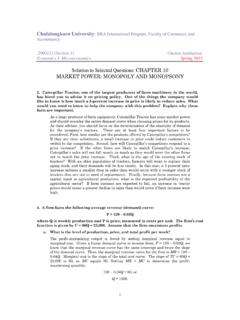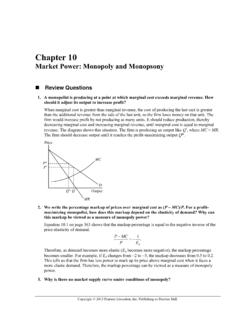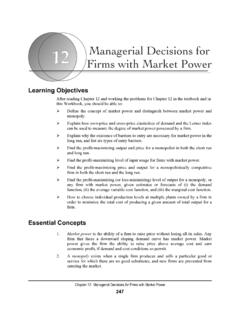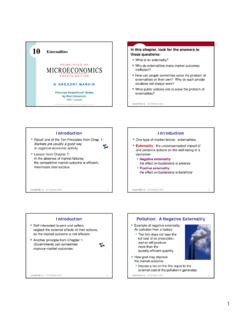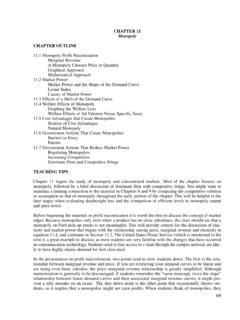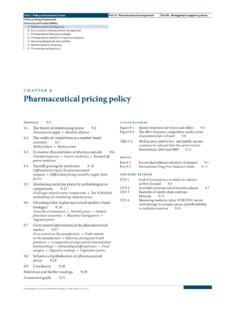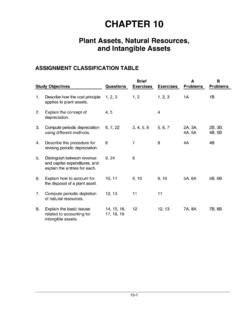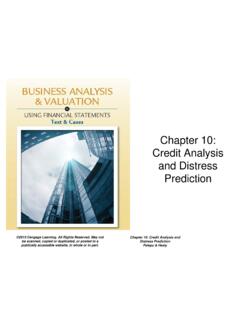Transcription of Chapter 10 Online Appendix: The Calculus of Price …
1 Chapter 10 of the textbook explores the market structures that tend to give rise to Price discrimination and the optimal pricing strategies of firms in each of these market struc-tures. In Chapter 9, we demonstrated that there was a deadweight loss associated with market power . Keep in mind that the market power in Chapter 9 was for a single- Price monopolist ( , the monopolist charged every buyer the same Price ). In this appendix, we show that in the special case of a perfect Price -discriminating monopolist, there is no deadweight loss associated with market power . In the final section, we demonstrate that a firm with market power can use a three-tiered pricing strategy to capture producer surplus that is greater than the producer surplus enjoyed by a single- Price monopolist.
2 Perfect Price -Discriminating Monopolist and Producer Surplus: A Numerical ExampleSuppose that the demand for high-end customized stereos in a particular city is given by q D = 200 , where P is the Price for a customized stereo. There is only one firm in this market providing such stereos. To simplify the analysis, we assume that there are no fixed costs. With no fixed costs, the firm s total variable cost and total cost are equivalent. The firm s total cost of providing high-end customized stereos is given by TC( q ppdm ) = 1 _ 30 q ppdm 3 5q ppdm 2 + 1,250 q ppdm , where q ppdm is the output choice of the perfect Price -discriminating monopolist.
3 Notice that in this exampleTC( q ppdm ) = 0 q ppdm MC(q)dqwhere MC(q) is the marginal cost perfect Price -discriminating monopolist can charge a different Price to each customer. Because we assume the firm in this market structure knows the value of the good to each customer, the firm can set each customer s Price to be her marginal benefit for the customized stereo. Marginal benefit is given by the inverse demand function. Using the demand function above, we have MB(q) = P = 20,000 100q. This pricing strategy implies that the firm s total revenue isTR( q ppdm ) = 0 q ppdm MB(q)dq = 0 q ppdm (20,000 100q)dqEvaluating the definite integral, we identify this perfect Price -discriminating monopo-list s total revenue function as 0 q ppdm (20,000 100q)dq = (20,000q 50 q 2 ) | 0 q ppdm TR( q ppdm ) = 20,000q ppdm 50 q ppdm 2 The firm s objective is to choose q ppdm to maximize profits.
4 In general, profits are = TR( q ppdm ) TC( q ppdm )The output level that maximizes firm profit is the same output level that maximizes producer surplus. In this example, profit and producer surplus are exactly the same (this is because Chapter 10 Online Appendix: The Calculus of Price Strategies10A-2 Part 3 Markets and Priceswe have assumed that there are no fixed costs for this firm). Formally, producer surplus isPS = TR( q ppdm ) 0 q ppdm MC(q)dqUsing our earlier result for total cost and the definite integral of marginal cost over our range of output, we find that PS = TR( q ppdm ) TC( q ppdm ), which is identical to our statement of firm profit.
5 Given the total revenue function we derived and the total cost function, the profit function is = 20,000 q ppdm 50 q ppdm 2 1 _ 30 q ppdm 3 + 5 q ppdm 2 1,250 q ppdm Combining like terms allows us to simplify profit as = 18,750 q ppdm 45 q ppdm 2 1 _ 30 q ppdm 3 The firm s first-order condition for maximization is0 = d _ dq ppdm = 18,750 90 q ppdm 1 _ 10 q ppdm 2 Because this equation is in the form of a quadratic equation, we may apply the qua-dratic formula to identify the choice of q ppdm that satisfies our first-order condition: q ppdm = 90 _____ 8,100 + 4 ( 1 _ 10 ) 18,750 ___ 1 _ 5 = ( 1, , )For a maximization, we require d 2 _ dq ppdm 2 < 0.
6 This implies d 2 _ dq ppdm 2 = 90 1 _ 5 q ppdm < 0 q ppdm > 450 Our profit-maximizing choice of output for the perfect Price -discriminating monopolist must be Profit and producer surplus at this quantity is PS = 18,750( ) 45( ) 2 1 _ 30 ( ) 3 = 1,724, Price -Discriminating Monopolist and Consumer Surplus With the optimal choice of the firm identified, let s now consider consumer surplus. Consumer surplus is given byCS = 0 q m (MB(q) P(q)) dqwhere q m is the market output level. Because the firm sets the Price at each increment of the output so P(q) = MB(q), we see thatCS = 0 q m (MB(q) MB(q)) dq = 0 q m 0dq = 0 Notice that this result will hold for all perfect Price -discriminating market settings.
7 Perfect Price -Discriminating Monopolist and Total Surplus For a market outcome to be efficient, total surplus TS (the sum of producer surplus and consumer surplus) must be maximized. Producer surplus is defined asPS = 0 q m (P(q) MC(q)) dqWith this expression for producer surplus and the expression we identified for consumer surplus in the previous section, we can write total surplus asTS = 0 q m (MB(q) P(q)) dq + 0 q m (P(q) MC(q)) dqOnline Appendix: The Calculus of Price Strategies Chapter 10 10A-3We can simplify this definite integral asTS = 0 q m (MB(q) MC(q)) dqGiven that a perfect Price -discriminating monopolist chooses P(q) = MB(q), producer surplus is exactly the full amount of total surplus in this market structure.
8 That is,TS = 0 q m (MB(q) MC(q)) dq + 0 q m (P(q) MC(q)) dq = PSThus, the firm s choice of output to maximize profits corresponds precisely with the condition for efficiency in this market setting. If the firm accomplishes the profit-maximizing objective, the market outcome is efficient. fi gure it outSuppose that a firm with market power can perfectly Price -discriminate and faces the demand function q = 400 4P. The firm s total production costs are given by MC(q) = 2q + q 2 .a. If the firm cannot Price -discriminate, identify the firm s profit-maximizing output and If the firm cannot Price -discriminate, identify consumer surplus and producer surplus in the market , assuming that the firm maximizes profits.
9 Calculate the deadweight loss from market If the firm can perfectly Price -discriminate, identify the firm s output If the firm can perfectly Price -discriminate, identify consumer surplus, producer surplus, and the deadweight loss from market :a. Using the firm s demand function, we can find the inverse demand function: P = 100 This implies that total revenue is given by TR(q) = P(q) q = 100q q 2 Marginal revenue is thereforeMR dTR(q) _ dq = 100 To maximize profit, the non- Price -discriminating firm must produce the quantity at which MR = MC: MR = 100 = 2q + q 2 = MC Solving for q requires us to identify q such that 2 + 100 = 0.
10 Using the quadratic formula, we find that q = _____ + 4( )100 __ = ( , )10A-4 Part 3 Markets and PricesThe second-order condition for profit maximization requires d 2 _ dq 2 = < 0q > , we conclude that the profit-maximizing level of output is q = The optimal Price is therefore P = For a non- Price -discriminating firm, producer surplus isPS = 0 ( 2q q 2 )dq= ( q 2 q 3 ) | 0 = ( ) ( ) 2 ( ) 3 = 1, surplus isCS = 0 (100 )dq= 0 ( )dq= ( q 2 ) | 0 = ( ) ( ) 2 = maximum possible total surplus in the market with a nondiscriminating monopo-list is 1, Next, we re going to determine the DWL associated with production of the good by a single- Price monopolist.


